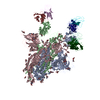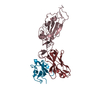+ Open data
Open data
- Basic information
Basic information
| Entry | Database: PDB / ID: 8a99 | |||||||||
|---|---|---|---|---|---|---|---|---|---|---|
| Title | SARS Cov2 Spike in 1-up conformation complex with Fab47 | |||||||||
 Components Components |
| |||||||||
 Keywords Keywords |  VIRAL PROTEIN / Spike / VIRAL PROTEIN / Spike /  Antibody Antibody | |||||||||
| Function / homology |  Function and homology information Function and homology informationMaturation of spike protein / viral translation / Translation of Structural Proteins / Virion Assembly and Release / host cell surface / host extracellular space / suppression by virus of host tetherin activity / Induction of Cell-Cell Fusion / structural constituent of virion / entry receptor-mediated virion attachment to host cell ...Maturation of spike protein / viral translation / Translation of Structural Proteins / Virion Assembly and Release / host cell surface / host extracellular space / suppression by virus of host tetherin activity / Induction of Cell-Cell Fusion / structural constituent of virion / entry receptor-mediated virion attachment to host cell / host cell endoplasmic reticulum-Golgi intermediate compartment membrane / receptor-mediated endocytosis of virus by host cell / Attachment and Entry /  membrane fusion / positive regulation of viral entry into host cell / receptor-mediated virion attachment to host cell / membrane fusion / positive regulation of viral entry into host cell / receptor-mediated virion attachment to host cell /  receptor ligand activity / host cell surface receptor binding / fusion of virus membrane with host plasma membrane / fusion of virus membrane with host endosome membrane / receptor ligand activity / host cell surface receptor binding / fusion of virus membrane with host plasma membrane / fusion of virus membrane with host endosome membrane /  viral envelope / symbiont-mediated suppression of host type I interferon-mediated signaling pathway / virion attachment to host cell / SARS-CoV-2 activates/modulates innate and adaptive immune responses / host cell plasma membrane / virion membrane / viral envelope / symbiont-mediated suppression of host type I interferon-mediated signaling pathway / virion attachment to host cell / SARS-CoV-2 activates/modulates innate and adaptive immune responses / host cell plasma membrane / virion membrane /  membrane / identical protein binding / membrane / identical protein binding /  plasma membrane plasma membraneSimilarity search - Function | |||||||||
| Biological species |   Severe acute respiratory syndrome coronavirus 2 Severe acute respiratory syndrome coronavirus 2  Homo sapiens (human) Homo sapiens (human) | |||||||||
| Method |  ELECTRON MICROSCOPY / ELECTRON MICROSCOPY /  single particle reconstruction / single particle reconstruction /  cryo EM / Resolution: 2.5 Å cryo EM / Resolution: 2.5 Å | |||||||||
 Authors Authors | Hallberg, B.M. / Das, H. | |||||||||
| Funding support | 1items
| |||||||||
 Citation Citation |  Journal: Immunity / Year: 2023 Journal: Immunity / Year: 2023Title: Immunoglobulin germline gene polymorphisms influence the function of SARS-CoV-2 neutralizing antibodies. Authors: Pradeepa Pushparaj / Andrea Nicoletto / Daniel J Sheward / Hrishikesh Das / Xaquin Castro Dopico / Laura Perez Vidakovics / Leo Hanke / Mark Chernyshev / Sanjana Narang / Sungyong Kim / ...Authors: Pradeepa Pushparaj / Andrea Nicoletto / Daniel J Sheward / Hrishikesh Das / Xaquin Castro Dopico / Laura Perez Vidakovics / Leo Hanke / Mark Chernyshev / Sanjana Narang / Sungyong Kim / Julian Fischbach / Simon Ekström / Gerald McInerney / B Martin Hällberg / Ben Murrell / Martin Corcoran / Gunilla B Karlsson Hedestam /  Abstract: The human immunoglobulin heavy-chain (IGH) locus is exceptionally polymorphic, with high levels of allelic and structural variation. Thus, germline IGH genotypes are personal, which may influence ...The human immunoglobulin heavy-chain (IGH) locus is exceptionally polymorphic, with high levels of allelic and structural variation. Thus, germline IGH genotypes are personal, which may influence responses to infection and vaccination. For an improved understanding of inter-individual differences in antibody responses, we isolated SARS-CoV-2 spike-specific monoclonal antibodies from convalescent health care workers, focusing on the IGHV1-69 gene, which has the highest level of allelic variation of all IGHV genes. The IGHV1-6920-using CAB-I47 antibody and two similar antibodies isolated from an independent donor were critically dependent on allele usage. Neutralization was retained when reverting the V region to the germline IGHV1-6920 allele but lost when reverting to other IGHV1-69 alleles. Structural data confirmed that two germline-encoded polymorphisms, R50 and F55, in the IGHV1-69 gene were required for high-affinity receptor-binding domain interaction. These results demonstrate that polymorphisms in IGH genes can influence the function of SARS-CoV-2 neutralizing antibodies. | |||||||||
| History |
|
- Structure visualization
Structure visualization
| Structure viewer | Molecule:  Molmil Molmil Jmol/JSmol Jmol/JSmol |
|---|
- Downloads & links
Downloads & links
- Download
Download
| PDBx/mmCIF format |  8a99.cif.gz 8a99.cif.gz | 686.1 KB | Display |  PDBx/mmCIF format PDBx/mmCIF format |
|---|---|---|---|---|
| PDB format |  pdb8a99.ent.gz pdb8a99.ent.gz | 563.3 KB | Display |  PDB format PDB format |
| PDBx/mmJSON format |  8a99.json.gz 8a99.json.gz | Tree view |  PDBx/mmJSON format PDBx/mmJSON format | |
| Others |  Other downloads Other downloads |
-Validation report
| Arichive directory |  https://data.pdbj.org/pub/pdb/validation_reports/a9/8a99 https://data.pdbj.org/pub/pdb/validation_reports/a9/8a99 ftp://data.pdbj.org/pub/pdb/validation_reports/a9/8a99 ftp://data.pdbj.org/pub/pdb/validation_reports/a9/8a99 | HTTPS FTP |
|---|
-Related structure data
| Related structure data |  15273MC  8a94C  8a95C  8a96C M: map data used to model this data C: citing same article ( |
|---|---|
| Similar structure data | Similarity search - Function & homology  F&H Search F&H Search |
- Links
Links
- Assembly
Assembly
| Deposited unit | 
|
|---|---|
| 1 |
|
- Components
Components
| #1: Protein | Mass: 142395.391 Da / Num. of mol.: 3 Source method: isolated from a genetically manipulated source Source: (gene. exp.)   Severe acute respiratory syndrome coronavirus 2 Severe acute respiratory syndrome coronavirus 2Production host:   Homo sapiens (human) / References: UniProt: P0DTC2 Homo sapiens (human) / References: UniProt: P0DTC2#2: Protein | Mass: 13520.063 Da / Num. of mol.: 3 Source method: isolated from a genetically manipulated source Source: (gene. exp.)   Homo sapiens (human) / Production host: Homo sapiens (human) / Production host:   Homo sapiens (human) Homo sapiens (human)#3: Antibody | Mass: 11398.565 Da / Num. of mol.: 3 Source method: isolated from a genetically manipulated source Source: (gene. exp.)   Homo sapiens (human) / Production host: Homo sapiens (human) / Production host:   Homo sapiens (human) Homo sapiens (human)#4: Polysaccharide | 2-acetamido-2-deoxy-beta-D-glucopyranose-(1-4)-2-acetamido-2-deoxy-beta-D-glucopyranose  / Mass: 424.401 Da / Num. of mol.: 8 / Mass: 424.401 Da / Num. of mol.: 8Source method: isolated from a genetically manipulated source #5: Sugar | ChemComp-NAG /  N-Acetylglucosamine N-AcetylglucosamineHas ligand of interest | Y | |
|---|
-Experimental details
-Experiment
| Experiment | Method:  ELECTRON MICROSCOPY ELECTRON MICROSCOPY |
|---|---|
| EM experiment | Aggregation state: PARTICLE / 3D reconstruction method:  single particle reconstruction single particle reconstruction |
- Sample preparation
Sample preparation
| Component | Name: SARS-CoV-2 Spike 1-up conformation in Complex with Fab47 Type: COMPLEX / Entity ID: #1-#3 / Source: MULTIPLE SOURCES |
|---|---|
| Molecular weight | Value: 629 kDa/nm / Experimental value: NO |
| Source (natural) | Organism:   Homo sapiens (human) Homo sapiens (human) |
| Source (recombinant) | Organism:   Homo sapiens (human) Homo sapiens (human) |
| Buffer solution | pH: 7.5 |
| Specimen | Conc.: 0.9 mg/ml / Embedding applied: NO / Shadowing applied: NO / Staining applied : NO / Vitrification applied : NO / Vitrification applied : YES : YES |
Vitrification | Instrument: FEI VITROBOT MARK IV / Cryogen name: ETHANE / Humidity: 100 % / Chamber temperature: 277 K |
- Electron microscopy imaging
Electron microscopy imaging
| Experimental equipment |  Model: Titan Krios / Image courtesy: FEI Company |
|---|---|
| Microscopy | Model: FEI TITAN KRIOS |
| Electron gun | Electron source : :  FIELD EMISSION GUN / Accelerating voltage: 300 kV / Illumination mode: FLOOD BEAM FIELD EMISSION GUN / Accelerating voltage: 300 kV / Illumination mode: FLOOD BEAM |
| Electron lens | Mode: BRIGHT FIELD Bright-field microscopy / Nominal magnification: 163000 X / Nominal defocus max: 3000 nm / Nominal defocus min: 1000 nm / C2 aperture diameter: 20 µm Bright-field microscopy / Nominal magnification: 163000 X / Nominal defocus max: 3000 nm / Nominal defocus min: 1000 nm / C2 aperture diameter: 20 µm |
| Specimen holder | Cryogen: NITROGEN / Specimen holder model: FEI TITAN KRIOS AUTOGRID HOLDER |
| Image recording | Average exposure time: 1.2 sec. / Electron dose: 56 e/Å2 / Film or detector model: GATAN K3 BIOQUANTUM (6k x 4k) / Num. of grids imaged: 1 |
- Processing
Processing
| Software | Name: PHENIX / Version: 1.20.1_4487: / Classification: refinement | ||||||||||||||||||||||||||||||||||||||||
|---|---|---|---|---|---|---|---|---|---|---|---|---|---|---|---|---|---|---|---|---|---|---|---|---|---|---|---|---|---|---|---|---|---|---|---|---|---|---|---|---|---|
| EM software |
| ||||||||||||||||||||||||||||||||||||||||
CTF correction | Type: PHASE FLIPPING AND AMPLITUDE CORRECTION | ||||||||||||||||||||||||||||||||||||||||
| Symmetry | Point symmetry : C1 (asymmetric) : C1 (asymmetric) | ||||||||||||||||||||||||||||||||||||||||
3D reconstruction | Resolution: 2.5 Å / Resolution method: FSC 0.143 CUT-OFF / Num. of particles: 111023 / Num. of class averages: 1 / Symmetry type: POINT | ||||||||||||||||||||||||||||||||||||||||
| Atomic model building | Protocol: RIGID BODY FIT | ||||||||||||||||||||||||||||||||||||||||
| Atomic model building | PDB-ID: 7A25 Accession code: 7A25 / Source name: PDB / Type: experimental model | ||||||||||||||||||||||||||||||||||||||||
| Refine LS restraints |
|
 Movie
Movie Controller
Controller






 PDBj
PDBj







